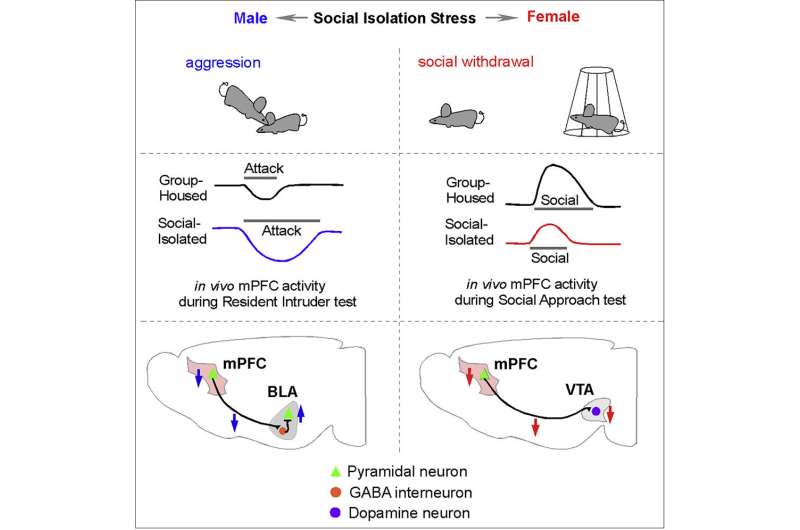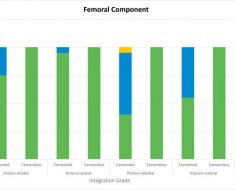
The mental health crisis that has resulted from the imposition of lockdowns and stay-at-home orders due to COVID-19 has been widely observed around the world. Now, University at Buffalo researchers have determined in a preclinical study that social isolation affects adolescent males and females in markedly different ways.
The research, published on March 23 in Cell Reports, provides evidence that many brain functions, including stress responses, have sex-specific differences.
The UB study is among the first to compare gender differences in responses to the stress of social isolation. The findings will not only help establish therapeutic targets for psychiatric disorders, but also shed light on which therapies might ultimately prove effective in males versus females.
Gender-based responses to stress
For more than 15 years, Zhen Yan, Ph.D., SUNY Distinguished Professor in the Department of Physiology and Biophysics in the Jacobs School of Medicine and Biomedical Sciences at UB, has been conducting preclinical research exploring how stress affects brain functions.
She explained that most studies of stress have traditionally examined males exclusively, but that changed after her team published a 2014 study in Molecular Psychiatry that found that young female rats were more resilient to repeated modest stress than males.
“That study attracted widespread attention,” she said. “The National Institutes of Health, which is funding our research, started to ask investigators to study stress and many other topics in both males and females.”
The UB study of chronic social isolation covered the entire period from juvenile to early adulthood in mice. “We quickly noticed the contrast in behaviors between the stressed males exhibiting heightened aggression versus the stressed females exhibiting social withdrawal,” said Yan.
To pinpoint which neuronal activity changes might be driving these behavioral differences, Yan and her team developed a technique of in vivo multichannel electrophysiological recording of free-moving animals, so that the excitability of multiple neurons could be precisely measured simultaneously during the performance of behavioral tasks.
Neurophysiological basis for sex-specific stress responses
One focus of the study is pyramidal neurons in the prefrontal cortex, the part of the brain responsible for executive function, such as planning and attention.
These neurons project out to, and affect, other brain regions, such as the basolateral amygdala (BLA), which is responsible for emotional responses.
Yan explained that the prefrontal cortex and the basolateral amygdala are known to be brain regions involved in aggression. “Our study provides the direct link between dampened pyramidal neuron activity in the prefrontal cortex and basolateral amygdala hyperactivity, which results in increased aggression in isolation-stressed males,” she said.
An important function of the prefrontal cortex, she noted, is the inhibition of inappropriate behavior.
“When prefrontal cortex pyramidal neuron activity is dampened, such inhibition is lost,” said Yan. “We found that when the males were stressed, the hypofunction of the prefrontal cortex led to hyperactivity of BLA principal neurons, which are directly involved in aggression.”
The mice in the study were the equivalent of what would be adolescence in humans. During this developmental period, Yan said that it is necessary for the mice to engage with other mice to develop peer play behaviors. These normal social behaviors are seen as essential preparation for adult life in both animals and humans.
But the UB study showed that the socially isolated males turned what would be normal incidents of play with other mice into aggressive attacks.
By contrast, in these situations, the isolation-stressed females exhibited social withdrawal.
Yan explained that in non-stressed females, in vivo electrophysiological recordings show that prefrontal cortex pyramidal neurons are activated by social stimuli during social engagement.
“However, such activation is diminished in stressed females, which is accompanied by their reduced interest in social interaction,” she said.
To investigate the circuit mechanisms downstream of the prefrontal cortex, the UB team focused on the ventral tegmental area (VTA) in the brain, which is involved in reward and reinforcing behaviors, key features of social interaction. They found that hypoactivity of VTA dopamine neurons is involved in stress-induced social withdrawal in females.
The researchers further examined how chemogenetic manipulation of the prefrontal cortex and its target regions including BLA and VTA may allow for the normalization of neuronal activity and behaviors in stressed males and females. “This will provide insights into future developments of interventions that could precisely target aberrant neuronal circuits,” said Yan.
Source: Read Full Article




